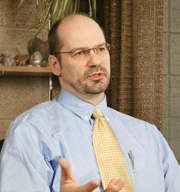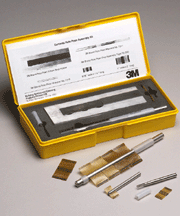E-Archive
Interview
in Vol. 6 - May Issue - Year 2005
Embracing Customer Needs!

Peter Fritz, Six Sigma Manager for Abrasive Systems Division, 3M


Interview with Peter Fritz, Six Sigma Manager for Abrasive Systems Division, 3M™ Company.
(?) MFN: You work for a very well known company. Please tell us a bit more.
(!) P. F.: Thank you for this opportunity to be interviewed by your magazine. We do not often get the chance to speak directly to a wide audience of expert users in this industry and welcome the chance.
As you know, 3M is a 103 year old company that has operations in more than 60 countries worldwide and sales offices in about 200. 3M manufactures over 60,000 products that are used in everything from computers to aircraft to your home. In order to effectively address those very diverse needs, 3M is managed through approximately 45 Divisions aligned around specific technology platforms and market segments. For example, Abrasive Systems Division (ASD) is aligned around abrasive platforms and also markets its products through multiple channels, such as the Aerospace and Aircraft Maintenance Department (AAMD). In this way, one group focuses on the platform and another implements the platform through market specific applications. 3M is a truly matrixed corporation, in that regard.
(?) MFN: Most people do not know that 3M produces products for the peening industry. What kind of products are these?
(!) P. F.: There are several of the products that 3M manufactures which enjoy a great deal of visibility in the aerospace industry in the field of peening. You may be surprised to know that these products, 3M™ Roto Peen Flap Assemblies Type TC 330 (hereafter referred to as TC 330), are manufactured through the Abrasive Systems Division (ASD) and are sold worldwide into aircraft repair and maintenance applications. The TC 330 family of products have been sold for over thirty years into these applications and started as products targeted at military applications. TC (stands for Tungsten Carbide) 330 (the effective size of the peening dimple) was developed to effect spot defect repair in the field under MIL-SPEC 81840 & 81841. The initial work done to qualify this product under the auspices of the US military was conducted at Wright-Patterson Air Force Base in Ohio.
Specifically, these products are composed of the following: 1. Tungsten Carbide shot, 2. A flexible matrix, 3. A strip of tape joining the two flap segments together
This comprises an article; commonly know as a flap assembly or peening flap. Although apparently simple in design, the background research supporting this product is extensive and, as a result, accepted for use on aircraft through the FAA.
In addition to the military applications mentioned above, use of this product rapidly spread to other applications in the commercial production of aircraft, as defect removal and spot repair are a normal aspect of manufacturing. The features that so appeal to aircraft mechanics are, 1. the control of the peening shot by being “captured” on the flap, 2. better control of the Almen intensity through the rotational speed of the tool, and 3. no need to clean up lost shot. By its very nature, the product is portable and easily put to use in small areas.
As you can see, there are three sizes of flaps. The most commonly used product would be the 1”(25mm) x 2”(50mm) Flap Assembly, which can be applied to flat surface areas and the inside diameter (ID) of holes down to 1.25”(31mm). Please see chart 1 of suggested application areas for each size of flap.
The 1” x 2” Flap Assemblies can also be ganged together, in order to more rapidly peen larger surface areas in less time. Flap Assemblies have also been trimmed using scissors to get into very tight areas and corners. Additional types of applications where these products have been used are:
-Landing gear assemblies
-Wing structures
-Helicopter rotor hubs
-Jet engine support members
-Peening after grinding
-Peening before plating
-Peening of surfaces subject to stress corrosion
-Peen straightening
-Peen forming
-Weld heat affect zone, and
-Bond testing
Many customers inquire of us how to obtain training on the use of these products. As part of our ongoing service to this industry, 3M has worked with the FAA in qualifying a training module specific to these products; Shot Peening Using TC330 Assemblies. I am also pleased to acknowledge that MFN has done the same and has begun to offer these services as well. Our common goal here is to enhance the capability of the expert in the field in the proper use of these products and we welcome our partnership.
(?) MFN: You have the title of Six Sigma Manager. What does that mean?
(!) P. F.: Six Sigma was introduced to 3M in November 2001 with the arrival of our current CEO, James McNerney. Originally developed at Motorola, it is a methodology used to reduce variability in manufacturing as well as business processes. This has become a key Corporate Initiative that has delivered tremendous financial gains to 3M since its introduction.
In my case, I have been highly trained in the use of this methodology and deployed on a number of special projects to grow 3M sales. I am referred to as a Black Belt internally as the result of this appointment. As an offshoot to the benefits 3M appreciates from this methodology, we have also begun offering this specialty to customers as a way of effectively getting at their pain and implementing tangible solutions. I am particularly pleased with the results of the customer projects that I have been engaged in the past twelve months. Using Six Sigma has provided a common language for rooting out causes of variability in every aspect of a customer’s manufacturing process. The satisfaction that we have attained as diverse multi-company teams goes far beyond any expectations that I could have imagined.
For example, in the use of the tools there are moments that become quite revealing for all participants. These are key junctures that result in very large changes and positive outcomes for our customers and partners. Needless to say, strong relationships grow out of this activity that are lasting and have impact. The professional growth that I have gained through this experience is just tremendous, not to mention the in-depth exposure to other manufacturing processes. The discipline required in using the Six Sigma methodology has created depths of understanding that would take years to accomplish through traditional classroom education.
By extension, Six Sigma has also been applied to our work in the peening industry. Many aspects of re-qualifying and enhancing our peening products for use in aerospace have been heavily influenced by Six Sigma. Our goal is to have our customers insist on 3M solutions, because ASD adheres to processes to better understand customer needs and deliver highly valued solutions that make them more successful. Six Sigma is another way to drive home that promise to our customers.
This is an exciting time for 3M and our partners and we welcome the opportunity to work with you into the future. Thank you again for the opportunity to speak with you.
We at MFN would like to thank Peter Fritz for this interview.
For Information:
3M Company
St Paul, Minnesota, USA
Tel: +1.651.736 6821
www.3M.com/abrasives



























